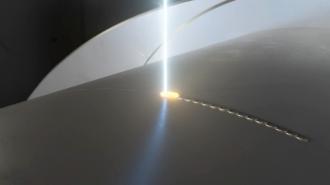Electron beam welding — a technique that fuses materials on an atomic level — could help make small modular reactors a part of our clean energy future.
The challenge: Nuclear power is cleaner than burning fossil fuels and more dependable than wind or solar power, but many existing nuclear power plants are nearing the end of their lives.
Building comparable replacements for them would be hugely expensive and time consuming. Combine those costs with a public wary of nuclear power due to high-profile meltdowns, and you get a nuclear industry that’s now on the decline.
Thinking small: Small modular reactors (SMRs) might be able to revive the nuclear power industry.
Unlike traditional reactors, which are massive and built on site, these systems are designed to be much smaller and could be built in factories. They can then be shipped to a site for assembly, and because they wouldn’t take up as much room, they could be built in more places.
For SMRs to be a part of the clean energy future, manufacturing costs need to be as low as possible.
While SMRs wouldn’t generate as much electricity as traditional, large-scale nuclear reactors, the process of making them could be faster and cheaper, and multiple units could be combined to increase output. Their small size and modern features might also make them safer.
The potential benefits of SMRs are still unproven, though. US regulators have only certified one SMR design, and a project to build a plant using those reactors was canceled in November 2023 due to a ballooning budget that made the system more expensive than wind or solar.
Electron beam welding: For SMRs to be a part of the clean energy future, developers need to figure out how to get manufacturing costs as low as possible, and a technology being industrialized by British engineering firm Sheffield Forgemasters could help make that happen.
It’s called “electron beam welding,” and it uses a beam of electrons to fuse materials on an atomic level. The technique was invented in the 1950s, and manufacturers in the auto and aerospace industries are already using it to produce high-quality welds.
“The electron beam welding process is not only faster but also produces a cleaner, stronger weld.”
Gareth Barker
To demo how electron beam welding could accelerate SMR manufacturing, Sheffield Forgemasters used the technique to weld a nuclear pressure vessel, the part of an SMR that holds the nuclear fuel.
It would take 120 to 150 days to make this weld using traditional methods, according to the UK firm, but it was able to complete the process in just two hours using the advanced technique.
“The electron beam welding process is not only faster but also produces a cleaner, stronger weld,” Gareth Barker, the company’s chief engineer, told BNN Breaking. “This means we can create nuclear pressure vessels that are more reliable and longer-lasting.”
Looking ahead: Sheffield Forgemasters has been manufacturing parts for the nuclear power industry since the 1950s, and it has already signed memorandums of understanding with several SMR developers, including Rolls-Royce and GE Hitachi Nuclear Energy.
If the firm’s use of electron beam welding can help these companies make SMRs cost-effective, it could revive the nuclear power industry in the UK and beyond.
We’d love to hear from you! If you have a comment about this article or if you have a tip for a future Freethink story, please email us at tips@freethink.com.
